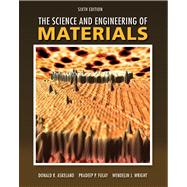This text provides an understanding of the relationship between structure, processing, and properties of materials. By selecting the appropriate topics from this wealth of material, instructors can emphasize materials, provide a general overview, concentrate on mechanical behavior, or focus on physical properties.
Since the book has more material than is needed for a one-semester course, students will also have a useful reference for subsequent courses in manufacturing, materials, design, or materials selection.
Features:
-Chapter Openings and Introductions introduce the student to relevant topics and ideas covered in that chapter.
-Have You Ever Wondered? questions designed to pique the interest of the reader relate the material covered in the chapter to its real world application.
-Considerably more focused on core Materials Science.
-Includes end-of-chapter design problems and chapter summaries.
-A glossary of key words and definitions can be found at the end of each chapter.








